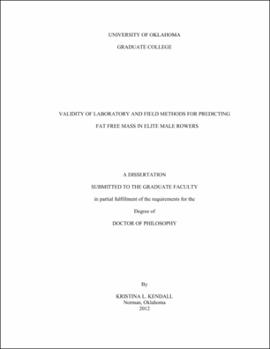| dc.description.abstract | The purpose of this study was to determine the validity of air displacement plethysmography, ultrasound, near-infrared interactance, and skinfold measurements in estimating fat-free mass in elite male rowers. Twenty-three elite-level male rowers participated in this investigation. All participants were members of the High Performance Training Center located in Oklahoma City, OK and had a minimum of 4 years of training experience. All body composition assessments were performed on the same day in no particular order, except for hydrostatic weighing (HW), which was measured last. All participants were asked to refrain from food 8 to 12 hours prior to testing (ad libitum water intake was allowed up to one hour prior to testing), and were instructed to avoid exercise for at least twenty-four hours prior to testing. Hydration status was determined prior to all testing using specific gravity via handheld refractometry to ensure proper hydration prior to testing. Fat-free mass (FFM) was evaluated using the four compartment model (4C), which included the measures of total body water (TBW) from bioimpedance spectrospcy (BIS), body volume from hydrostatic weighing (HW), and total body bone mineral (TBBM) via dual energy x-ray absorptiometry (DEXA). Estimates of FFM via air displacement plethysmography (BOD POD®), near infrared interactance (Futrex® 6100/XL), ultrasound (IntelaMetrix BX-2000), and the 3-site Jackson and Pollock skinfold equation (Sum3) were validated against the criterion method, 4C model. The major findings of the study were that all independent techniques evaluated overestimated FFM and should not be considered valid for the assessment of FFM in elite male rowers. Future studies should use multiple compartment models for the estimation of FFM, and include the measurement of TBW and TBBM. | |
